1483-85. Parentage and Early Life
The last of England's line of Plantagenet kings, Richard III, was born at Fotheringhay Castle in Northamptonshire on 2nd October 1452. Richard was the eleventh child in a large family and the fourth surviving son of Richard Plantagenet, Duke of York, (premier descendant of Lionel, Duke of Clarence, the third son of Edward III) and Cecily Neville. Cecily was the daughter of Ralph Neville, Earl of Westmorland and Joan Beaufort, Joan herself was the illegitimate daughter of John of Gaunt.
The White boar standard of Richard III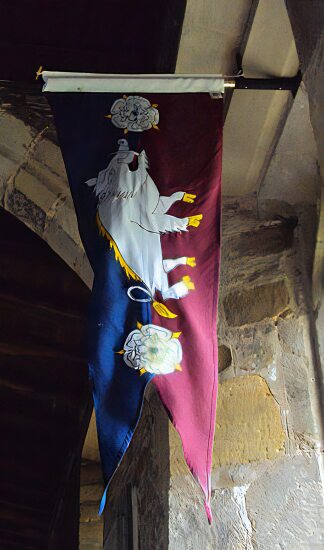
His was a difficult birth, his mother was at a precarious age for childbearing in the middle ages and the child was a breech. As an infant Richard was weak and sickly and not expected to survive the perils of childhood in the late middle ages.
The young Richard grew up amidst the violent civil strife of the Wars of the Roses, it formed and moulded him and he was very much the product of that turbulent age. His father, Richard, Duke of York, challenged the Lancastrian King Henry VI's right to the throne. After a prolonged struggle for possession of England's crown, both his father and his brother, Edmund, Earl of Rutland, were killed by Lancastrian forces under Margaret of Anjou at Sandal Castle, at Christmas, 1460. Their heads, York's crowned with a paper coronet in derision, were struck on the walls of York.
The Yorkist claim to the throne passed to the young Richard's eldest brother, Edward, a competent general, he defeated the Lancastrians, deposed Henry VI and was crowned at Westminster Abbey as King Edward IV in 1461. Richard received his education at Middleham Castle in Yorkshire in the household of his influential maternal cousin, Richard Neville, later to be known to history as Warwick the Kingmaker.
He was created Duke of Gloucester on 1st November 1461, after the accession of his brother, Edward IV, to the throne. The title was traditionally a royal one but considered to be an unlucky one. Shakespeare states in his Henry VI, part three that " Gloucester's Dukedom is too ominous" a reference to its previous holders, Thomas Duke of Gloucester, youngest son of Edward III, who was murdered by supporters of his nephew Richard II, while Humphrey Duke of Gloucester, brother of Henry V, suffered a similar fate during the reign of his nephew, Henry VI. Richard adopted the white boar (see right) as his badge, along with the motto 'Loyaulte me lie' (Loyalty binds me.)
Anne Neville with her husbands, Edward of Lancaster and Richard III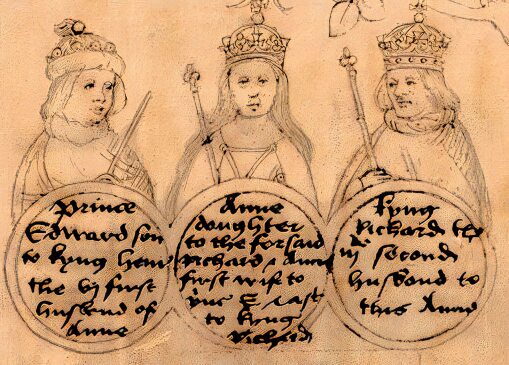
Richard, Duke of Gloucester
On the death of the mighty Earl of Warwick at the Battle of Barnet, Richard married his recently widowed younger daughter, Anne Neville. Anne had previously been the wife of Edward, the Lancastrian Prince of Wales, who had been killed during or after the decisive Yorkist victory at Tewkesbury. Anne and Richard were first cousins once removed, both descended from Ralph Neville, Earl of Westmorland and Joan Beaufort, the daughter of John of Gaunt, Duke of Lancaster, third surviving son of Edward III.
Richard had first met his future wife when he was taken into her father's household at Middleham Castle on the death of his father, in 1460. Contemporary accounts vary as to how Anne's first husband met his death, some state he was killed in battle, others that he was murdered during its aftermath by Edward IV, Richard and Lord Hastings.
Anne was taken to Coventry after the Battle of Tewkesbury then moved to her sister Isabel and her husband George, Duke of Clarence's home in London. Richard of Gloucester, then in his late teens, requested, and was granted, permission from Edward IV, to marry Anne, who was co-heiress to her father's vast estates. Clarence, who was eager to secure the whole Neville inheritance for himself, opposed the marriage. There are varying accounts of what happened subsequently, one states that she escaped from Clarence's household and sought refuge in a London cookshop disguised as a servant. Richard is said to have traced her and escorted her to sanctuary at the Church of St Martin le Grand. The couple were married on 12th July 1472, at Westminster Abbey, Richard and Clarence then engaged in a lengthy dispute over who should inherit a bulk of the Neville and Beauchamp estates, although Anne's mother, Anne Beauchamp was still living, her property was divided between her two sons-in-law. A disgraceful act of Parliament stated she should be deemed legally dead.
The marriage produced one child, Edward of Middleham, later Prince of Wales, born in December 1473, although Richard is known to have at least two illegitimate children, a son, John of Gloucester (who was later claimed to be executed by Henry VII) and a daughter, Katherine Plantagenet, who was married to the Earl of Huntingdon.
Richard made his power base in the north, where he now owned vast estates and acted as his brother's lieutenant in the region. Disliking the Queen, Elizabeth Woodville and her upstart and grasping relations, he stayed away from court as much as was practically possible, living mainly at Middleham in Yorkshire.
Richard III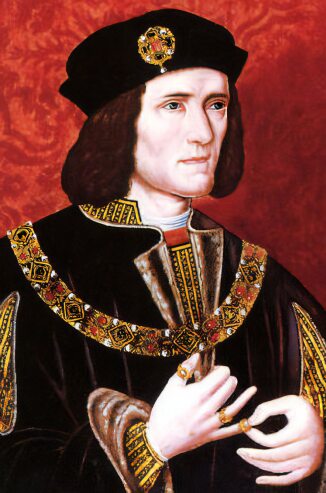
Richard's appearance
Richard was said to ressemble his father. Unlike his brothers Edward IV and George, Duke of Clarence, both tall and well built, Richard was short, slightly built and dark haired. His skeleton revealed that he suffered from scoliosis, or curvature of the spine, which meant that one shoulder would have been higher than the other, the condition is different from kyphosis, which is a condition of a curving of the spine that causes a bowing or rounding of the back, which leads to a hunchback.
No evidence was found on his remains of a withered arm, Shakespeares 'blasted sapling'. Richard was sickly as a child, the fifteenth century Silesian nobleman Nicolas von Poppelau, who met Richard and liked him, stated Richard was taller and slimmer than himself, not so solid and far leaner with delicate arms and legs. John Rous recorded Richard was "slight in body and weak in strength". Katherine FitzGerald, who is said to have once danced with him at the court of Edward IV, described him as handsome.
Reign
On the death of his brother Edward in April 1483, Richard interrupted the progress of the new king, his nephew, Edward V, at Stony Stratford. Woodville, Grey and others of the boy's escort were sent to Richard's power base in the north. Anthony Woodville and Richard Grey, despite reassurances to the contrary, were later executed on Richard of Gloucester's orders. The young King, now in the custody of his uncle Richard and Henry Stafford, Duke of Buckingham, continued on his progress to London. News of the dramatic occurrences at Stony Stratford raced ahead of them, Queen Elizabeth Woodville, in a state of agitation, fled to Westminster Abbey with her daughters and her younger son, Richard, Duke of York. Avaricious as ever, she did not fail to take all her possessions into the sanctuary with her.
Gloucester and Buckingham entered London with the young king and a large body of armed men from the north. Panic spread, most people had been taken by surprise and astonishment was rife at the speed of events. An unmistakable atmosphere of coup d'etat gripped the city. While the grasping Woodvilles had been unpopular, King Edward IV had been much loved by the people, and therefore most were loyal to his son. Richard of Gloucester eased apprehension by explaining he was only countering a Woodville conspiracy aimed at himself and "the old nobility of the realm". This explanation was generally accepted and the fears which had gripped London were calmed.
The young King Edward V was lodged in the Tower of London ostensibly awaiting his coronation. There was nothing sinister detected in this at the time when the Tower was a royal residence as well as a prison. On the pretext that his brother required his company and the Queen was being foolish, the ten-year-old Richard, Duke of York, was removed from the safety of sanctuary at Westminster and taken to join him in the Tower.
At a meeting of the council at the Tower on the thirteenth of June, ostensibly to discuss Edward V's coronation, Gloucester, the Lord Protector, had William, Lord Hastings suddenly and unexpectedly arrested on a charge of treason. Hastings, while he detested the Woodvilles, had been a close friend of Edward IV and would never have countenanced the disinheriting of his children. He was executed, without trial, the same day on a block of wood. Edward IV's mistress Jane Shore, who had been taken up by Hastings, was humiliatingly forced to walk barefoot in her petticoat through the streets of London with a taper in her hand. This punishment did not have the effect Richard planned, instead the crowds who gathered to watch the spectacle were moved to pity and impressed with the dignity she displayed during her ordeal.
Richard III and Anne Neville from the Rous Roll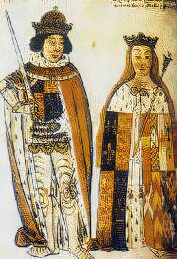
The legitimacy of the young Edward V then began to be actively questioned, and the old claim of Edward IV not being the true son of Richard, Duke of York was resurrected by Buckingham, who stated that the late King's true father had been an archer named Blaybourne, who was supposed to have had an adulterous affair with Cecily, Duchess of York. The two young princes had been seen playing in the Tower gardens at various times until then. Gradually, they began to appear less frequently. The last person to see them alive was Edward V's physician, Dr Argentine, who had attended him at the Tower and found him in a state of abject melancholy.
Questions were raised in his reign concerning Edward's legitimacy, it was noted that he looked nothing like his father, the short and dark Richard Plantagenet. Rumours were promoted by the Earl of Warwick in 1469 and repeated by George, Duke of Clarence shortly before his death in 1478, but with no evidence. It was suggested that the real father may have been an archer called Blaybourne. until recently, the generally accepted view was that issue was a fallacy raised to support both the claims of his brothers George and later Richard III.
Prior to his succession to the throne, on June 22, 1483, Richard III is said to have declared that his older brother was illegitimate. The Act of Titulus Regius describes Richard III as "the undoubted son and heir" of Richard, Duke of York, Mancini states that Edward's mother, Cecily Neville, known as 'Proud Cis' herself began this story, when she was informed of Edward's secret marriage to Elizabeth Woodville, the outraged Cecily is reported to have declared that she was tempted to swear he was illegitimate and thereby have him removed from the throne for his foolishness.
In 2003, Dr Michael Jones disclosed in a Channel 4 documentary by Tony Robinson evidence from Rouen Cathedral. In the cathedral register, an entry in 1441 records that the clergy were paid for a sermon for the safety of the Duke of York, going to Pontoise on campaign. He would have been on campaign from July 14 to August 21, 1441, which was several days' march from Rouen. Unless he was born prematurely, which is not recorded, By counting back from Edward's birth on April 28, it would seem that Richard of York was not present at the time of Edward's conception around the first week of August 1441. Furthermore, the cathedral records reveal that Edward's christening was carried out in private in a side chapel of the Rouen Cathedral, while at the christening of Richard and Cecily's second son, Edmund, Earl of Rutland, the whole cathedral was used for a huge celebration, again suggesting to supporters of the theory that Edward was indeed illegitimate, although the Duke of York never disclaimed his paternity of his eldest son. Some historians have offered criticism of this theory in that it is logistically possible for Richard Duke of York to have returned briefly from battle to Rouen.
It remains debatable as to whether Richard had Edward and his younger brother, Richard, Duke of York, murdered in the Tower. Revisionists claim that his ally the Duke of Buckingham, or his successor, Henry Tudor had just as much cause to remove them from his path to the throne as did Richard. Opinion about his role in his nephew's disappearance has oscillated between two extremes, one is the picture painted by Shakespeare of a murderous monster who ruthlessly liquidated all who stood in his path to power, the other is of a much maligned and conscientious ruler.
Much evidence to support both claims has been raised. At a distance of more than five hundred years, it is impossible to state with certainty who was responsible for ordering the murder of Edward V and his young brother, all that can be said with certainty is that rumour was rife at this time that they had been done away with and that they were never seen alive again. (For an account of the mysterious disappearance of the two Princes in the Tower, see our section on Edward V). Richard's coronation took place on 6th July 1483, Buckingham was created Constable and great Chamberlain of England and magnificently clad, held the King's train at the ceremony.
King Richard III then set out on a royal progress. When he reached the city of York, where he was popular, England's only north country King was well received. His son, Edward of Middleham, was created Prince of Wales in a magnificent ceremony at York Minster.
Sheriff Hutton Castle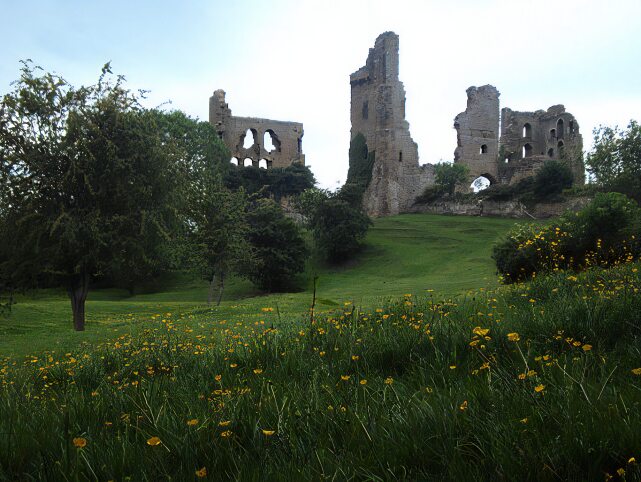
Sheriff Hutton Castle
In July 1484, during the period when he served as Lord of the North, Richard established Sheriff Hutton Castle, around six miles (10km) from York, as one of the headquarters of the Council of the North, the other was at Sandal Castle. The council was to last for a century and a half.
The castle was founded as a motte and bailey castle by one Bertram de Bulmer, Sheriff of York, during the reign of King Stephen. In 1331 the powerful and influential Neville family obtained overlordship of Sheriff Hutton and Bulmer's castle was rebuilt in stone in the late fourteenth century by John, Lord Neville, son of John Neville, 3rd Baron Neville de Raby.
Richard acquired the castle from his father-in-law, Richard Neville, Earl of Warwick, or 'Warwick the Kingmaker' whose lands he inherited on the death of the latter at the Battle of Barnet in 1471.
Edward, Earl of Warwick, the young son of George Duke of Clarence and at the time under attainder, was sent to Sheriff Hutton in 1484 for safekeeping, as was Richard's nephew and heir, John de la Pole, Earl of Lincoln.
Richard's niece, Elizabeth of York, later destined to become the mother of the formidable Henry VIII, was also housed at the castle for a spell, when her suspected arrangement to marry the then pretender, Henry Tudor, (later Henry VII) placed her under suspicion.
Richard III sat uneasily on his throne in 1483, the deep distrust of the nobility had been engendered by the manner of Lord Hastings demise and the apparent disappearance of Edward V and his brother. At Lincoln, on 11th October, Richard received the disconcerting news that his greatest ally, the Duke of Buckingham, had deserted his cause and risen against him. Buckingham's reasons remain obscure, he was said to regret his former conduct, but it may have been that he did not feel himself rewarded richly enough for it. It has been suggested that, as he was directly descended from Edward III's youngest son himself, his earlier support of Richard was part of a design to clear his own path to the throne.
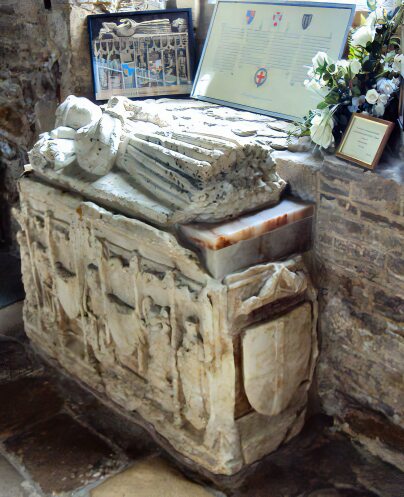
In conspiracy with the Woodvilles and the Lancastrian pretender, Henry Tudor, Earl of Richmond, Buckingham rose simultaneously with them. Tudor possessed a (somewhat flawed) claim to the throne himself through the Beaufort family, illegitimate descendants of John of Gaunt's liaison with Katherine Swynford.
Henry Tudor's ships ran into a storm and were forced to return to Brittany. The Duke of Norfolk, who remained loyal to the king, blocked their way to London. Buckingham's army began to desert. Morton, who had probably incited the rebellion himself, fled to Flanders. Buckingham then abandoned the remnants of his army but was captured and his requests for an audience with the king refused, he was beheaded on Richard's orders.
Parliament passed the Act of Titulus Regius, ratifying Richard's claim to the throne and bastardising Edward IV's children. To acquire a trusted ally, Richard married his illegitimate daughter, Katherine, to the Earl of Huntingdon and promoted him to high office in Wales. The King replied in the north on the Earls of Westmorland and Northumberland, and Lord Stanley, an unwise action, since the latter was married to Henry Tudor's mother, Lady Margaret Beaufort.
Tragically, in April, Richard's only son, Edward of Middleham, Prince of Wales, a delicate child, died, possibly of tuberculosis. Both Richard and his wife Anne Neville were said to be distracted with grief.
A monument to Richard's only legitimate son stands in the medieval church of St. Helen and Holy Cross, in the village of Sheriff Hutton. The prince died suddenly at Middleham Castle in Yorkshire in 1484, the exact date of his death remains a matter of controversy, with some sources citing 31st March as the date and others 9th April.
Richard later appointed his sister's son, John de la Pole, as his successor. Edward, earlier known as Earl of Salisbury, was born at Middleham Castle between April 1473 and December 1474. It is suspected that Edward, believed to have been a delicate child, was too ill to travel to his parents' coronation at Westminster Abbey on 6th July 1483, but was appointed nominal Lord Lieutenant of Ireland on 19th July.
He was invested as Prince of Wales at a ceremony at York Minster on 24th August. The mutilated white alabaster effigy, believed to be that of Edward of Middleham, in the church at Sheriff Hutton is not a tomb but a cenotaph (i.e. it is empty). The monument was dismantled at some unknown date, attempts at cleaning and conservation were made in the nineteenth-century and the monument was finally reassembled in the twentieth century and provided with a new core and damp course at the expense of the Richard III Society.
The house in Shrewsbury where Henry Tudor lodged during his march to Bosworth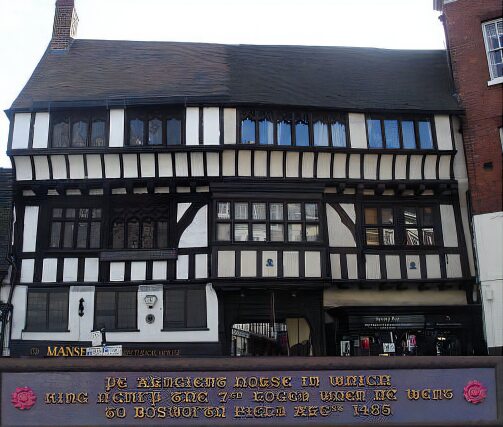
Many in that superstitious age saw the death of Richard's only son as divine retribution for his treatment of his brother Edward IV's sons. Clarence had left a son Edward Plantagenet, Earl of Warwick, but he remained under his father's attainder and Richard decided to appoint his sister Elizabeth's son, John, Earl of Lincoln, as his heir.
Elizabeth Woodville's daughters were received at court and Elizabeth of York, the eldest of them, inciting much gossip, was provided with dresses similar to the Queen's. In March 1485, when Queen Anne Neville died at the age of about twenty-eight, probably from tuberculosis, her husband was said to be unwilling to visit her in her quarters. The day she died, there was an eclipse, which many took to be an omen of Richard's fall from heavenly grace.
After Anne's death rumours arose that he had poisoned her and was planning to marry his niece, Elizabeth of York, to secure a stronger claim to the throne. Although ungrounded in fact, they amply illustrate Richard's subjects suspicions of him. He was forced to make a humiliating public denial of the rumours, stating that he was not glad at her death "but as sorry and as heavy in heart as a man can be" and to deny that he harboured plans for an incestuous marriage with his niece.
Queen Anne Neville was given a magnificent funeral and was buried at Westminster Abbey, in an unmarked grave to the right of the High Altar, next to the door to Edward the Confessor's Chapel.
By the spring of 1485, the King was aware that Henry Tudor planned a further invasion. Tudor, now in Paris, had secured the support of the French regent Anne of Beaujeu, who supplied him with troops for an invasion of England. Richard waited at Nottingham for news, to ensure the loyalty of Lord Stanley, whom he now distrusted, he kept his eldest son, George, Lord Strange, hostage by his side.
Henry Tudor embarked from Harfleur and landed at Mill Bay in Pembrokeshire, South Wales on 7 August, then celebrated as the Feast of the Transfiguration. Wales was traditionally a Lancastrian stronghold, where Henry gathered much support from the Welsh, amassing an army of around 5,000. He was accompanied by his paternal uncle Jasper Tudor, Earl of Pembroke and John de Vere, Earl of Oxford, and around 2,000 French mercenaries. The town of Shrewsbury opened its gates to him on 15th August and from there he advanced through Stafford and Atherstone.
Edward V PreviousNext Anne Neville
